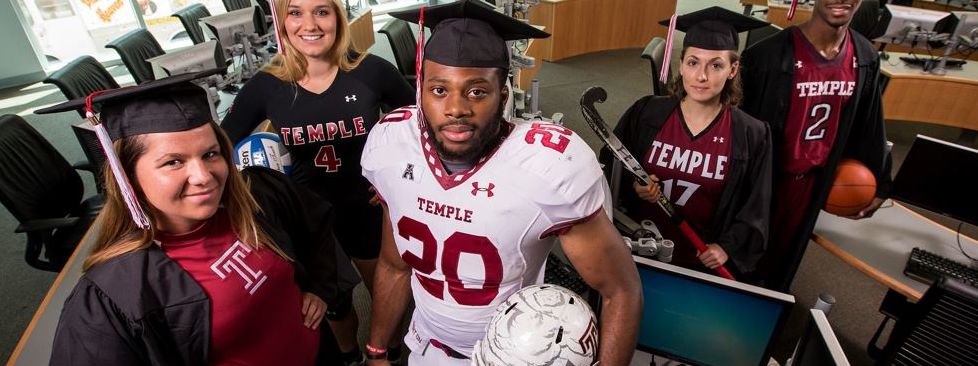 For over a year, since NCAA laws changed, student-athletes have been able to monetize their name, image and likeness (NIL). But many schools have been struggling to navigate this landmark change.
For over a year, since NCAA laws changed, student-athletes have been able to monetize their name, image and likeness (NIL). But many schools have been struggling to navigate this landmark change.
Fortunately, at Temple University, student-athletes have a built-in advantage. Thilo Kunkel, associate professor and director of the Sport Industry Research Center at the School of Sport, Tourism and Hospitality Management (STHM), is an NIL expert. His recent research has explored how athletes are able to gain specific value from their social media profiles—and how this positions women and athletes in less-popular sports to benefit from the ruling.
Starting last fall, Kunkel has applied his research and insights to support Temple student-athletes in a class designed just for them.
STHM initiates collaboration across the university
Kunkel spearheaded the idea of bringing his work directly to Temple student-athletes, which turned into a collaboration with the university’s Nancy & Donald Resnick Academic Center for Student-Athletes.
“Student Athlete Development and Professionalism” is required of all incoming first-year student-athletes at Temple, but starting in fall of 2021, it had new, specially tailored NIL content. The first class took place just weeks after the Supreme Court ruling.
“This demonstrated agility on the part of Dr. Kunkel as well as the Resnick Center,” says Temple’s Vice Provost for Faculty Affairs Jeremy Jordan, previously the senior associate dean of STHM and Faculty Athletics Representative for the university. “They worked together quickly to translate the up-to-the-moment expertise of our faculty member into the classroom.”
Translating research into know-how
In fall 2021, more than 60 students took the “Development and Professionalism” class, which comprised a fairly even blend of men and women and a strong representation of international students. Some classes were in-person, accompanied by asynchronous sessions.
Kunkel created videos that the instructors presented to the various sections. He met weekly with instructors and offered oversight in how to deliver it and they then facilitated discussions and follow-up activities. As a result of the collaboration, four Resnick Center academic advisors received a dual appointment as adjunct STHM faculty members.
“From the beginning, Dr. Kunkel was very much involved in making sure the material was highly relatable for students,” says Tori Perri, one of the instructors. Student-athletes learned to position themselves and address the ruling’s legal and financial implications, including their image on social media in terms of strategy and impact. She says the students were able to make use of Kunkel’s insights almost immediately. “It made for a good combination of theory, research and what the students were most interested in talking about,” Perri adds.
How Temple athletes—and STHM students—benefit
One of the class objectives is for student-athletes to learn to align their personal conduct with professional standards. Kunkel facilitated an introduction to the pros and cons in their own branding. Later weeks of the class covered details of social media creation on various platforms and the legal and financial aspects, in terms of how to monetize NIL.
“The young athletes want to see examples and how these NIL issues relate to them,” Kunkel says. “Instead of a high-level analysis, I offered them step-by-step instructions and addressed some of the nuances in the power of their personal brand. This extends from what we mean by brand awareness for someone as relevant and diverse as LeBron James to lesser-known student-athletes who are at the start of their personal branding journey.”
Another aspect of Kunkel’s vision has been to devise an Athlete Branding class for STHM’s Sport and Recreation students, taught for the first time in fall 2021. It brings a more in-depth version of this same content to STHM undergraduates, who are interested from the perspective of a sport agent or professional working with athletes of a particular team.
Elevating the NIL issue
Kunkel says that he addresses the responsibility to set high standards for all athletes, whether it’s by making charitable contributions or simply showcasing an attractive lifestyle. “It gets to the issue of how we define a role model,” he says.
The students enjoy this aspect of the curriculum and have gained a new perspective on what they post on social media. They also have the chance to work in groups and Perri says there is value in seeing what other athletes have done and incorporating those tactics, which can mean launching a new initiative or getting a boost to enhance their followers.
“For a final project, they have the chance to look at who they are outside their sport,” she says, “and to consider that, if a company offers them a deal, that company’s values could inform their choices. The curriculum supports them in being at the forefront of the issue, while keeping in mind the big picture. And how they could develop a brand over years.”
For fall 2022 the Resnick Center has offered several sections of the same course. Kunkel says he is proud that STHM has been able to lead the way in supporting students right here on campus. “I’m glad the curriculum functions as a toolkit that these talented athletes can use going forward,” he says, “during their time at Temple and beyond.”
